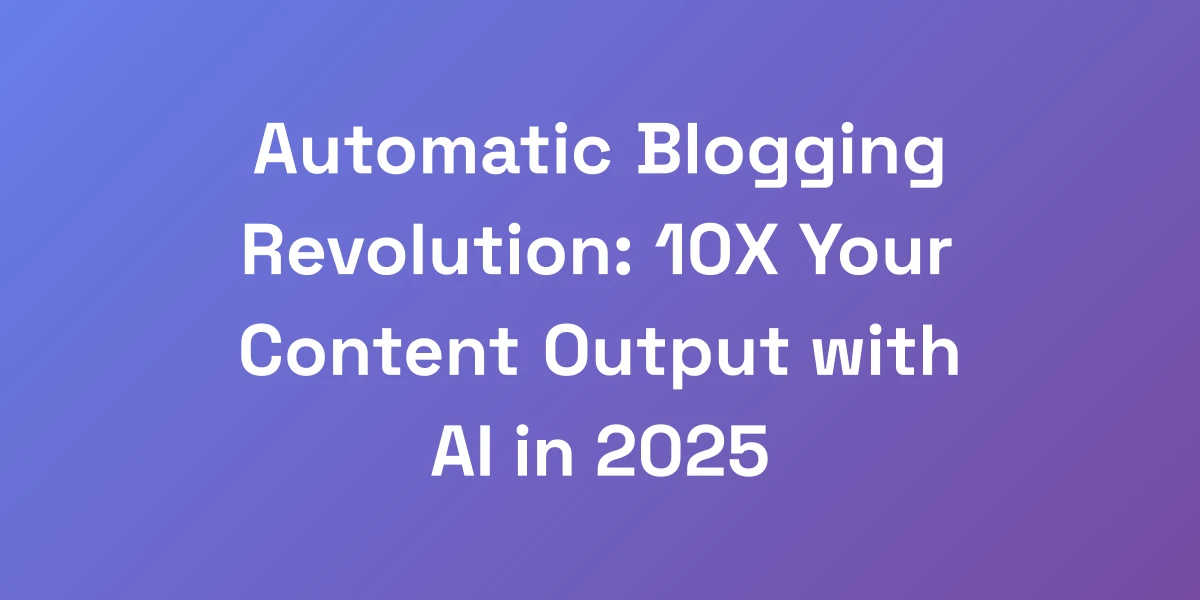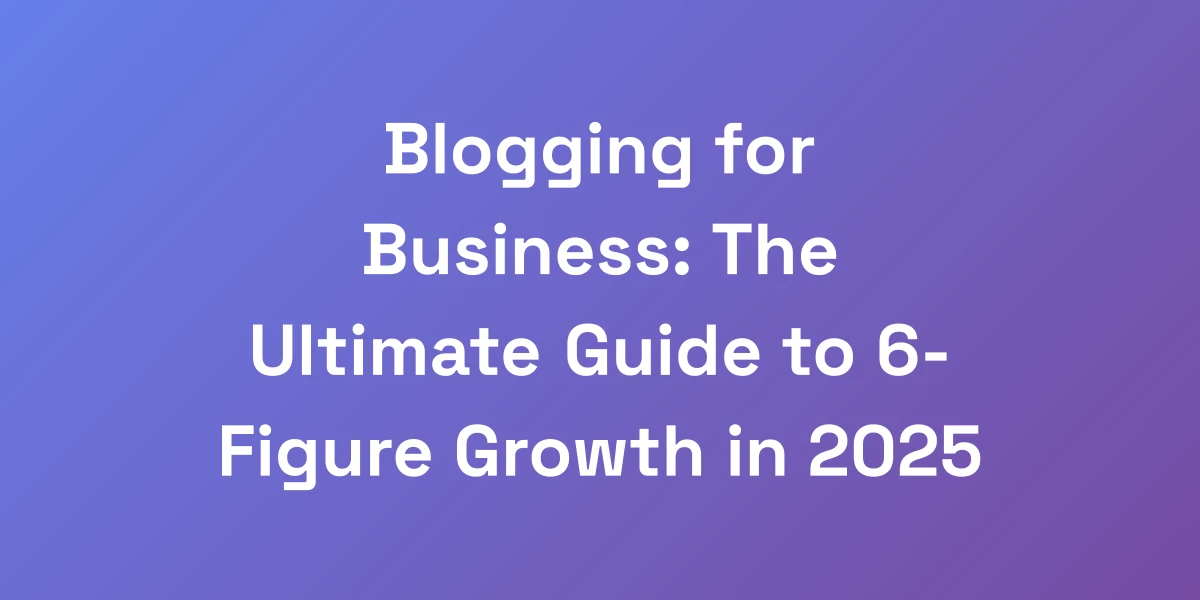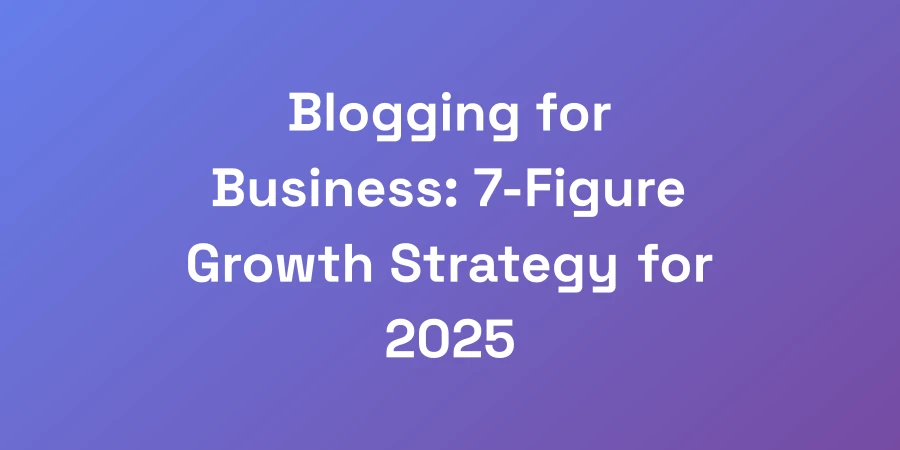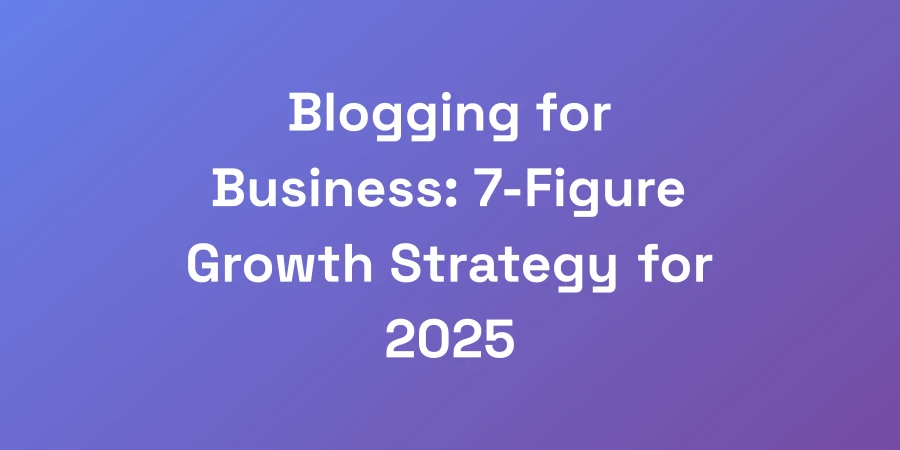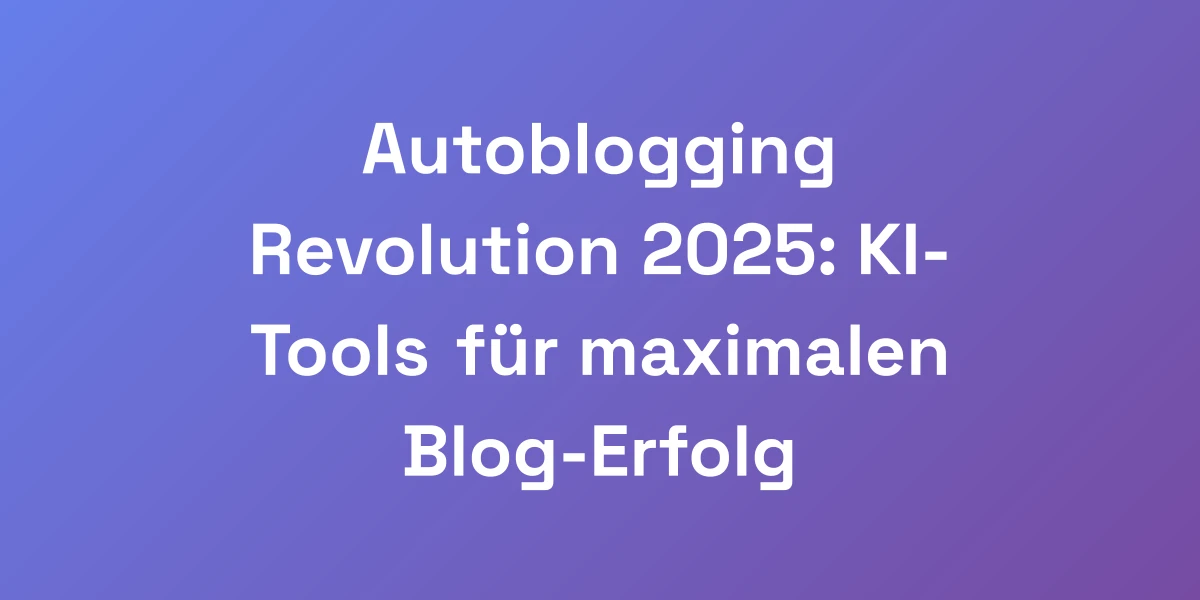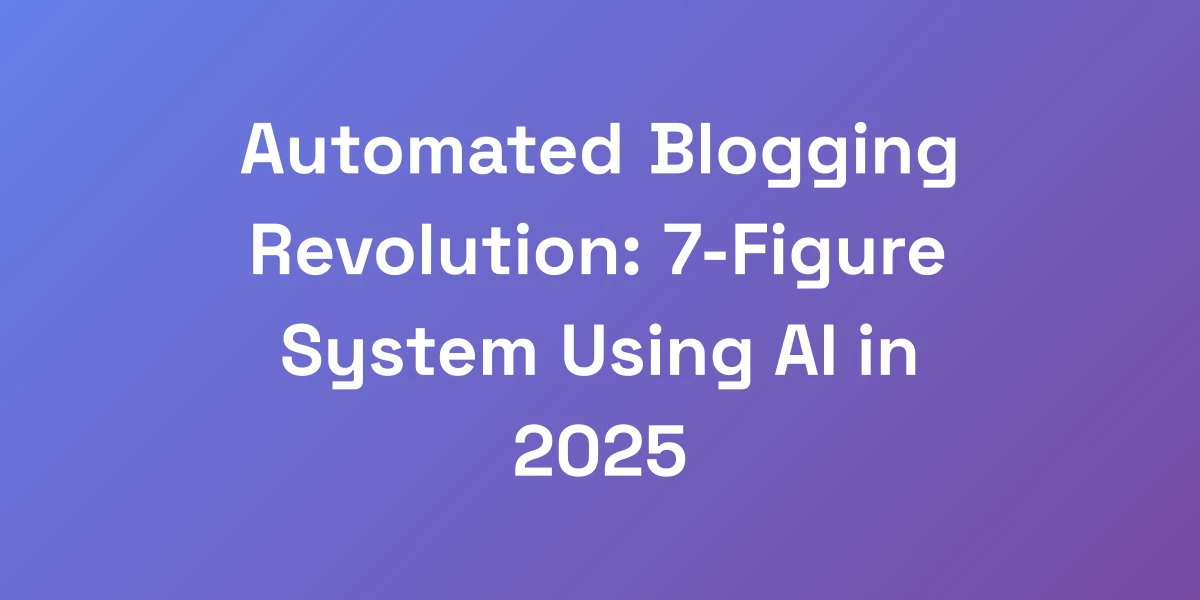
Automated Blogging Revolution: 7-Figure System Using AI in 2025
Mar 12, 2025 | By [email protected]
The New Era of Automated Blogging: Why 99% Are Doing It Wrong
Let me cut through the BS right now – most people trying automated blogging are leaving money on the table. They’re using basic AI tools to pump out mediocre content and wondering why they’re not seeing results.
Here’s the reality: automated blogging isn’t about replacing human writers – it’s about building a systematic content machine that leverages AI while maintaining quality. We’ve seen businesses scale to 7-figures using these exact systems, and we’re going to show you how to do it right.
The Costly Mistakes Killing Your Automated Blog
Automated blogging sounds like a dream come true, right? More content, less effort. But here’s the kicker: without the right approach, it’s a recipe for disaster.
One of the biggest mistakes is relying solely on AI to generate content without any human oversight. Sure, AI can churn out articles at lightning speed, but without proper editing, the quality often plummets.
- Lack of Quality Control: Automated systems might miss nuances, resulting in content that’s off-target or lacks depth.
- Ignoring SEO Best Practices: Generating content without integrating strategic keywords and semantic phrases can lead to poor search engine rankings.
- Failure to Engage: Content that doesn’t resonate with your audience will fail to convert, no matter how automated the process is.
To avoid these pitfalls, it’s crucial to implement robust quality control systems and ensure that your AI tools are configured to align with your SEO and engagement goals.
Why Traditional Blogging Is Dead (And What’s Replacing It)
Traditional blogging is losing its shine because it’s slow, labor-intensive, and often fails to keep up with the rapid pace of digital consumption.
What’s replacing it? Automation. By leveraging AI, we’re transforming blogging from a manual process into a streamlined, efficient machine that consistently delivers high-quality content.
Think about it: instead of spending hours crafting each post, your automated system can produce multiple articles daily, each optimized for SEO and tailored to your audience’s interests.
This shift not only saves time but also scales your content operations, allowing you to reach a wider audience and drive more traffic to your site.
The ROI Mathematics of Automated Content
Let’s break down the numbers. Automated blogging can significantly boost your ROI by reducing labor costs and increasing content output.
- Cost Efficiency: Automating content creation can cut down on hiring costs for writers, editors, and SEO specialists.
- Increased Output: With AI, you can produce more content in less time, leading to higher traffic and more opportunities for monetization.
- Scalability: Automated systems allow you to scale your content efforts without a proportional increase in costs.
For instance, consider a business that spends $5,000 monthly on content creation manually. By switching to an automated system costing $1,000, and increasing output by 300%, the ROI skyrockets, potentially pushing revenues into the 7-figure range.
Case Study: From 0 to 100k Monthly Visitors Using Automation
Take the example of a niche tech blog that struggled to gain traction. By implementing an automated blogging system, they transformed their content strategy.
Within six months, they ramped up their content production by 400%, focusing on high-value keywords and leveraging AI for optimization. The results? A surge from zero to 100,000 monthly visitors.
- Strategic Keyword Placement: Using AI to identify and integrate high-traffic keywords naturally.
- Consistent Publishing: Maintaining a steady flow of content to keep the audience engaged and improve SEO rankings.
- Quality Content: Ensuring each article provided genuine value, fostering trust and authority in their niche.
This case study underscores the power of automated blogging when executed with precision and strategic oversight.
The Truth About AI Content Detection
With the rise of AI-generated content, tools like GPTZero, Copyleaks, and Originality.ai have made AI detection nearly flawless, boasting accuracy rates over 99%.
This raises a critical question: Can you rely solely on AI for content creation without raising flags with search engines?
The answer is nuanced. While AI can generate content efficiently, human oversight is essential to ensure the content meets quality standards and aligns with Google’s E-E-A-T criteria (Experience, Expertise, Authoritativeness, Trustworthiness).
- Human Editing: Always have a human review and refine AI-generated content to enhance quality and authenticity.
- Balanced Approach: Combine AI efficiency with human creativity to produce content that resonates and performs well in search rankings.
- Continuous Monitoring: Regularly check your content with AI detection tools to ensure it remains compliant and high-quality.
By integrating human expertise with AI automation, you can maintain content integrity and achieve sustainable SEO success.
Learn more about AI accuracy benchmarking to further enhance your content strategy.
Building Your Automated Content Engine: The $100k Framework
Stop thinking about blog posts and start thinking about content systems. Your automated blogging setup needs to be a well-oiled machine, not a random collection of tools. We’re going to show you the exact framework that’s generating six figures monthly for our clients. It’s not about writing faster – it’s about building a content ecosystem that scales without sacrificing quality or authenticity.
The Core Tech Stack for Maximum Efficiency
Building a robust core tech stack is the foundation of any successful automated blogging system.
- AI Writing Tools: Use platforms like Jasper AI, Rytr, or Writesonic to generate high-quality content efficiently.
- SEO Optimization Tools: Incorporate tools like SEMrush or Ahrefs to guide keyword research and on-page SEO.
- Content Management Systems: Utilize WordPress or other CMS platforms that integrate seamlessly with your AI tools.
- Automation Platforms: Tools like Make.com can help automate the entire content creation and distribution process.
By selecting the right combination of these AI writing tools, you create a seamless workflow that maximizes productivity and ensures consistency across your content operations.
Setting Up Your Content Generation Pipeline
A well-structured content generation pipeline is crucial for maintaining steady and high-quality content flow.
- Idea Generation: Use AI-driven trend analysis tools to identify relevant and trending topics in your niche.
- Content Creation: Deploy your AI writing tools to draft articles based on identified topics and keywords.
- Editing and Optimization: Have human editors review and refine the AI-generated content for quality and SEO optimization.
- Publishing: Automate the scheduling and publishing process using your CMS and automation platforms.
This pipeline ensures that every piece of content undergoes a rigorous process of creation, review, and optimization, maintaining high standards and relevance.
Quality Control Systems That Scale
Scaling without compromising quality is the holy grail of automated blogging. Here’s how to achieve it:
- Automated Editing: Utilize AI tools for grammar and plagiarism checks to ensure initial content quality.
- Human Review: Implement a multi-tiered review system where human editors assess and enhance content.
- Feedback Loops: Create systems where feedback from readers and performance metrics inform future content adjustments.
- Standardized Guidelines: Develop comprehensive content guidelines that both AI and human editors can follow.
By integrating these quality control measures, your content remains reliable, engaging, and authoritative, even as you scale operations.
Integration Points for Maximum Automation
Seamless integration between your tools ensures maximum efficiency and minimal manual intervention.
- API Connections: Use APIs to connect your AI writing tools with your CMS, SEO platforms, and automation tools.
- Unified Dashboards: Create centralized dashboards that provide an overview of your entire content ecosystem.
- Data Synchronization: Ensure that data flows smoothly between tools, such as keyword research results feeding directly into content creation.
- Automated Workflows: Set up automated workflows that handle repetitive tasks like content scheduling, social media sharing, and email distribution.
These integration points minimize manual tasks, reduce errors, and ensure that your content system runs smoothly and efficiently.
Workflow Automation Secrets
Unlock the full potential of your automated blogging system with these workflow automation secrets:
- Task Automation: Automate repetitive tasks such as content scheduling, social media posting, and email marketing.
- Trigger-Based Actions: Set up triggers that initiate specific actions, like publishing an article once it’s approved or sharing it on social media once live.
- Conditional Workflows: Create workflows that adapt based on certain conditions, such as adjusting publishing times based on audience engagement metrics.
- Integration with Analytics: Connect your workflows with analytics tools to automatically track performance and adjust strategies in real-time.
These secrets help streamline your operations, reduce manual oversight, and ensure that your content system responds dynamically to performance data.
Content Distribution Automation
Creating great content is just half the battle. Distributing it effectively is where the magic happens.
- Social Media Automation: Use tools like Hootsuite or Buffer to schedule and automate social media posts across multiple platforms.
- Email Campaigns: Automate email newsletters that send out your latest posts to your subscriber list using platforms like Mailchimp or ConvertKit.
- Content Repurposing: Automatically convert your blog posts into different formats, such as videos or infographics, using AI tools.
- SEO Integration: Ensure your distribution channels are optimized for SEO, driving organic traffic to your content.
By automating distribution, you maximize the reach and impact of your content, ensuring it reaches your audience wherever they are.
AI-Powered Content Strategy That Actually Converts
Listen up – your AI tools are only as good as your strategy. The real money isn’t in the automation itself – it’s in how you position your content to convert. We’ve tested dozens of approaches, and we’re going to show you the exact content frameworks that are working right now. This isn’t about gaming the system; it’s about creating a content strategy that serves both search engines and humans.
Topic Cluster Automation
Organizing your content into topic clusters can dramatically improve SEO and user engagement.
- Core Topics: Identify broad topics that are central to your niche.
- Subtopics: Use AI to generate related subtopics that support and expand on your core topics.
- Interlinking: Automatically link subtopic articles to the core topic to create a robust internal linking structure.
- Content Mapping: Map out content across clusters to ensure comprehensive coverage and avoid topic cannibalization.
This approach not only boosts your SEO but also provides your readers with a well-structured and informative content journey.
SEO-Driven Content Planning
SEO shouldn’t be an afterthought – it should drive your content planning from the start.
- Keyword Research: Use AI tools like SEMrush or Ahrefs to identify high-traffic, low-competition keywords relevant to your niche.
- Content Gaps: Analyze competitor content to find gaps and opportunities for unique content creation.
- Search Intent: Ensure each piece of content aligns with the search intent of your target audience.
- On-Page Optimization: Optimize your content with strategic keyword placement, meta descriptions, and headers.
By integrating SEO into your content planning, you ensure that every piece of content you create is designed to perform well in search rankings.
Conversion-Focused Content Templates
Creating templates focused on conversion can streamline your content creation process and boost your results.
- Lead Magnets: Develop templates for content that includes lead magnets like eBooks, checklists, or webinars.
- Call-to-Actions (CTAs): Design templates with effective CTAs that guide readers towards desired actions.
- Sales Pages: Create templates for sales-driven content that highlights product benefits and includes persuasive elements.
- Landing Pages: Utilize landing pages optimized for conversions, ensuring they align with your overall content strategy.
These templates help maintain consistency, save time, and ensure that every piece of content is geared towards driving conversions.
Automated Keyword Research
Keyword research is the backbone of any successful content strategy. Automate this process to stay ahead of the game.
- AI Tools: Use tools like Ahrefs, SEMrush, or Moz to automate the discovery of high-value keywords.
- Trend Analysis: Implement AI-driven trend analysis to identify emerging keywords and topics.
- Competitive Analysis: Automatically assess competitor keywords to find opportunities for your own content.
- Keyword Mapping: Use automation to map keywords to specific content pieces, ensuring comprehensive coverage.
By automating keyword research, you can continuously optimize your content for the best possible search performance.
Content Calendar Automation
Managing a content calendar manually can be overwhelming. Automation simplifies the process, ensuring consistent publishing.
- Scheduling Tools: Use tools like Trello, Asana, or CoSchedule to automate your content calendar.
- AI Recommendations: Leverage AI to suggest optimal publishing times based on audience engagement metrics.
- Automatic Updates: Set up your calendar to automatically update with new content ideas and deadlines.
- Collaboration Features: Enable team collaboration by integrating your calendar with communication tools like Slack or Microsoft Teams.
This automation ensures that your content publishing stays on track, maintains consistency, and aligns with your strategic goals.
Performance Tracking Systems
Tracking the performance of your content is essential to refine your strategy and maximize ROI.
- Analytics Integration: Connect your content system with analytics tools like Google Analytics or Hotjar to monitor performance in real-time.
- Key Metrics: Focus on metrics such as traffic, engagement, conversion rates, and SEO rankings.
- Automated Reporting: Set up automated reports that provide insights into content performance without manual effort.
- Data-Driven Adjustments: Use performance data to make informed adjustments to your content strategy and optimization efforts.
With a robust performance tracking system, you can continuously improve your content strategy based on actionable insights.
Monetization Strategies for Automated Blogs
Here’s what nobody tells you about monetizing automated blogs: the money isn’t in the ads. The real profit comes from building systematic revenue streams that complement your content. We’re talking about creating multiple income channels that work together, leveraging your automated content to drive real business results. Let us show you how to turn your blog into a revenue-generating machine.
High-Ticket Offer Integration
High-ticket offers can significantly boost your revenue by providing premium value to your audience.
- Premium Courses: Create and sell in-depth courses that offer specialized knowledge in your niche.
- Consulting Services: Offer personalized consulting or coaching services to your readers.
- Exclusive Memberships: Develop membership programs that provide exclusive content, resources, or community access.
- Webinars and Workshops: Host paid webinars or workshops that deliver high-value content and interactive learning experiences.
By integrating high-ticket offers, you can generate substantial income while providing significant value to your audience.
Automated Lead Generation
Lead generation is the lifeblood of any profitable blog. Automate this process to capture and nurture leads efficiently.
- Lead Magnets: Use AI to create compelling lead magnets like eBooks, checklists, and whitepapers.
- Landing Pages: Automate the creation and optimization of landing pages to capture leads effectively.
- Email Funnels: Set up automated email sequences to nurture leads and guide them through the buyer’s journey.
- CRM Integration: Integrate your lead generation systems with CRM tools like HubSpot or Salesforce for seamless lead management.
Automating lead generation ensures a steady flow of potential customers, ready to convert into paying clients.
Strategic Affiliate Marketing
Affiliate marketing is a powerful way to monetize your blog without creating your own products.
- Relevant Partnerships: Choose affiliate products and services that align with your niche and provide genuine value to your audience.
- Content Integration: Seamlessly integrate affiliate links within your content to enhance credibility and conversion rates.
- Automated Recommendations: Use AI to recommend products based on user behavior and content context.
- Performance Tracking: Automate tracking of affiliate performance to optimize your strategies and maximize earnings.
By strategically implementing affiliate marketing, you can earn commissions while maintaining the trust and engagement of your audience.
Product Launch Automation
Launching products can be streamlined and highly effective with automation.
- Pre-Launch Campaigns: Use automated email sequences and social media posts to build anticipation before a product launch.
- Sales Funnels: Automate your sales funnels to guide customers from awareness to purchase seamlessly.
- Inventory Management: Integrate your product launch systems with inventory management tools to ensure smooth operations.
- Feedback Collection: Automatically gather and analyze customer feedback post-launch to refine future products.
Automation ensures that your product launches are efficient, well-coordinated, and highly effective in driving sales.
Email Marketing Integration
Email marketing remains one of the most effective monetization strategies when automated properly.
- Segmented Lists: Automatically segment your email lists based on user behavior and preferences for targeted campaigns.
- Personalized Content: Use AI to personalize email content, increasing engagement and conversion rates.
- Automated Drip Campaigns: Set up automated drip campaigns to nurture leads and guide them towards conversions.
- Performance Analytics: Integrate analytics to track email performance and optimize your strategies continuously.
By automating email marketing, you maintain consistent communication with your audience, driving higher engagement and sales.
Traffic Monetization Methods
Maximizing the monetization of your blog traffic involves multiple strategies working in harmony.
- Ad Networks: While not the primary revenue source, strategically placed ads can provide supplemental income.
- Sponsored Content: Collaborate with brands to create sponsored posts that align with your content and audience interests.
- Native Advertising: Integrate ads naturally within your content to enhance user experience while generating revenue.
- Subscription Models: Offer premium content behind a paywall, providing exclusive value to paying subscribers.
By diversifying your monetization methods, you ensure multiple revenue streams that complement each other and maximize your blog’s profitability.
Scaling Your Automated Blog to 7-Figures
Want to know the difference between a hobby blog and a 7-figure content business? It’s all in the scaling strategy. We’ve helped dozens of businesses scale their automated blogs, and there’s a clear pattern to success. It’s not about creating more content – it’s about creating strategic content that compounds over time. Here’s the exact playbook we use.
Team Structure for Scale
As your blog grows, so does the need for a well-structured team.
- Content Strategists: Develop and oversee the content strategy, ensuring alignment with business goals.
- AI Specialists: Manage and optimize the AI tools used for content creation and automation.
- Editors and Proofreaders: Maintain content quality through thorough editing and proofreading.
- SEO Experts: Optimize content for search engines, ensuring high visibility and traffic.
- Marketing and Sales Teams: Drive monetization strategies and manage revenue streams.
By building a dedicated team, you ensure that every aspect of your blog operates smoothly and efficiently, supporting scalable growth.
Content Multiplication Strategy
Maximize the value of each content piece through strategic multiplication.
- Repurposing: Turn blog posts into videos, podcasts, infographics, and social media content to reach different audiences.
- Syndication: Distribute your content across multiple platforms to increase visibility and reach.
- Guest Contributions: Invite guest writers to contribute, bringing fresh perspectives and expanding your content library.
- Content Upgrades: Enhance existing content with additional resources like downloadable guides or exclusive insights.
This strategy ensures that each piece of content works harder, reaching more people and driving more traffic and revenue.
Traffic Growth Systems
Driving consistent traffic is essential for scaling your blog to 7-figures.
- SEO Optimization: Continuously refine your SEO strategies to maintain and improve search rankings.
- Social Media Marketing: Leverage social media platforms to drive traffic and engage with your audience.
- Paid Advertising: Invest in targeted ads to boost traffic and reach new audiences quickly.
- Partnerships and Collaborations: Partner with other bloggers and influencers to tap into their audiences.
Implementing robust traffic growth systems ensures a steady influx of visitors, critical for sustained growth and revenue.
Authority Building Automation
Establishing authority in your niche is key to long-term success.
- Consistent High-Quality Content: Maintain a steady flow of valuable content that positions you as an expert.
- Backlink Strategies: Automate outreach for backlink opportunities to enhance your site’s authority.
- Engagement: Use automated systems to manage and respond to comments, fostering a community.
- Thought Leadership: Publish in-depth articles, research, and opinion pieces that showcase your expertise.
By automating authority-building efforts, you solidify your reputation and attract more loyal followers and customers.
International Scaling
Expanding your blog’s reach internationally can unlock new revenue streams.
- Multilingual Content: Use AI translation tools to create content in multiple languages, catering to global audiences.
- Localization: Adapt your content to resonate with different cultural contexts and regional interests.
- Global SEO: Optimize your content for international search engines and regional keywords.
- Targeted Marketing: Implement automated marketing campaigns tailored to different geographic segments.
International scaling ensures that your blog taps into diverse markets, enhancing growth opportunities and revenue potential.
Risk Management and Quality Control
Scaling comes with its own set of challenges. Effective risk management and quality control are essential to navigate these waters.
- Content Audits: Regularly audit your content to ensure it meets quality and compliance standards.
- Backup Systems: Implement automated backup systems to protect your content and data.
- Security Measures: Use automated security tools to safeguard your site from breaches and vulnerabilities.
- Performance Monitoring: Continuously monitor site performance and user behavior to identify and address issues promptly.
By proactively managing risks and maintaining quality control, you ensure your blog remains reliable, trustworthy, and resilient as it scales.
Conclusion
We’ve walked you through the intricate landscape of automated blogging and revealed a 7-figure system using AI poised to dominate in 2025. From avoiding costly mistakes and building a robust content engine to implementing strategies that convert and scaling your operations, the path to automated blogging success is meticulously mapped out.
Remember, it’s not just about harnessing AI for automation; it’s about creating a harmonious content ecosystem where technology and human expertise coexist to deliver unparalleled value.
Are you ready to transform your blogging game and unlock the full potential of automated systems? Take action today by implementing these strategies and watch your blog evolve into a revenue-generating powerhouse.
What challenges are you facing in your automated blogging journey? Share your thoughts and experiences in the comments below – let’s grow together!



